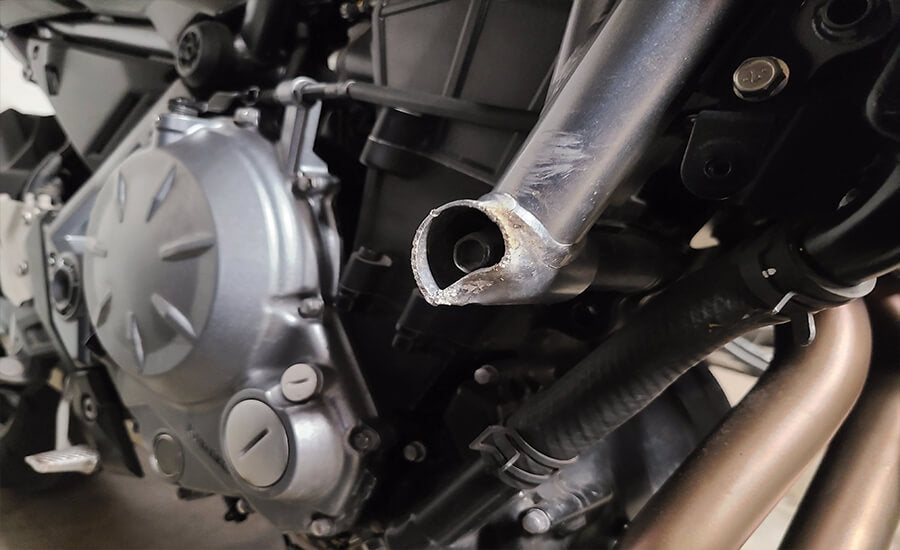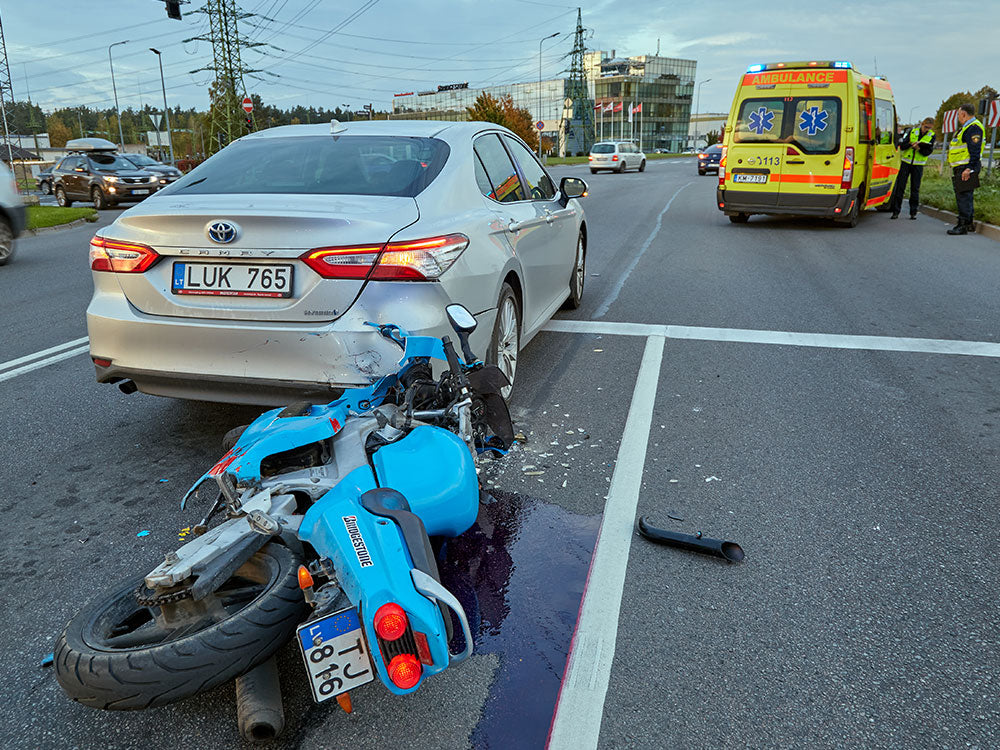Table of Content
1. Tires

If the motorcycle collided with another vehicle, there is a high chance that the front rim became bent. Also, if the tire hit any sharp object, the tire wall may have been cut or punctured.
Stand up the motorcycle and keep it propped up using the kickstand; then, slowly rotate the tire and check for any punctures or dents in the rim. If the tire is too badly damaged, it will need to be replaced.
Secondly, the rider also needs to check whether the tires is rotating without any resistance or imbalance. If there is any kind of wobble or unusual vibrations when rotating the tire, it would make it difficult to make turns or travel on a straight, open road.
2. Handlebars
When the motorcycle crashes against the ground, the handlebars may become bent or the alignment of the handlebars and wheels will no longer be straight. Handlebars that are damaged make it impossible to steer the motorcycle safely.
Riders should also check the throttle since a severe crash could cause the ride-by-wire mechanisms to become bent or cracked, damaging the cables that affect how responsive the throttle is. Do the same with the clutch, checking that it is not cracked, or bent, or that the cables have been damaged. If any wiring, cables, or controls were damaged, they will be costly to repair but are necessary if you wish to access your motorcycle’s electrical system and the functions connected to it.
3. Lighting and Electronics
If a crash resulted in the headlights and/or tail lights being damaged, you must check them and apply repairs before taking it for another ride. For touring motorbikes and expensive cruisers, they are built with a lot of controls and automated features connected to the electrical system, making repairs necessary.
Check all the lights on the motorcycle, including the headlights, tail lights, side indicators, and fog lights. Make sure that the lights turn on and off when prompted and that there is no cracked glass or broken bulbs.
4. Oil and Fluid Leaks

During a crash, parts of the engine that hold or transfer fluids may become damaged and start to leak. If there are any signs of oil leakage, immediately apply repairs since reduced oil levels reduce the engine’s lifespan. Also, check the brake fluid cables for any cracks or leakage since leaking brake fluid can reduce brake efficiency.
Stand a motorcycle on top of a clean surface or place a cloth under the engine before revving the engine a few times. Closely inspect the engine for any cracks or fluids leaking. Also, check for hard grease-like residues caked against the engine’s exterior. Other hard residues, like dirt, may gather on the engine if the motorcycle rides over a muddy surface or if there is an oil leakage that settles and hardens.
If the motorcycle has a shaft drive system, also check the exterior of the shaft to see if there are any cracks or any oil leaking. A shaft drive with a low oil level will cause the gear and shaft to wear out faster.
5. Chassis and Frame

In severe accidents, the chassis or frame may become bent which can expose delicate components or make it difficult to be seated on or steer the motorcycle. Repairing the chassis or frame can be expensive since it takes a lot of time to remove the parts, straighten the frame, and then put the parts back in. Cracks in the frame may not cause issues at first; however, it is dangerous to continue riding a motorcycle with a cracked frame since riding over any bumpy or unpaved roads can cause the cracks to deepen.
Also, check the condition of the drive train system as a crash may cause the chain/belt to become bent or get a crack that negatively affects its overall performance.
To check the drive train, stand up the motorcycle and rotate the rear tire to see if the chain moves correctly or not. If the motorcycle has a belt drive, rotate the rear wheel while checking the belt to see if it has become worn out or suffered any cracks.
6. Standing Position

Also Read: 10 TIPS ON HOW TO SURVIVE A MOTORCYCLE CRASH
7. Brakes
During an accident, the brake cable can suffer damage or the disc brake can become cracked or dented. Disc brakes must be replaced immediately; otherwise, the brakes don’t work properly and also ruin the brake pads.
Rather than riding the motorcycle to check the condition of the brakes, it is better to stand the motorcycle upright, rotate the wheels, and then apply the brakes. In case, of any problem immediately change them as well.
8. Exterior
Checking the exterior is the first thing most riders do after a crash. The following things are needed to be checked while checking the motorcycle’s exterior, see if the fenders have any dents, cracks, or scratches. You should also inspect the fairings for any cracks or scratches. Any scratches can be removed by applying polish or quality scratch removers.
9. Strange Noises
Start and rev the engine a few times, listening for any knocking or other strange noises. Strange engine noises may imply issues with the carburetor or fuel injection, exhaust, or engine head. If your motorcycle is suffering from premature combustion, this may also cause the engine to make strange noises.
10. Suspension

Suspensions may become bent or dented if the motorcycle crashes into something at high speed.
Check the front and rear suspensions for any signs of damage. If they suffered from minor dents, it is possible to repair them. However, if the suspensions suffer severe damage, it is better to replace them as soon as possible.
11. Tips to Reduce the Risk of Motorcycle Crashes
11.1 Avoid Speeding
Speeding is the most common cause of motorcycle crashes. Driving the motorcycle to its maximum revs and top speed is very fun but also dangerous as well. Every road has a set speed limit that determines the minimum speed that riders can legally travel without endangering themselves or other vehicles sharing the road.
11.2 Avoid Panic Braking
Many riders suddenly apply the front and rear brakes at the same time in response to danger, causing the motorcycle to slip or the rider to be thrown over the handles. It is best to reduce speed by slowly applying the brakes which results in a better braking experience rather than slipping the motorcycle.
11.3 Avoid Gravel
Gravel is not common on well-developed roads; however, on longer rides or when off-roading, riders may travel over gravel roads more often. Try to avoid the gravel if possible, but if there is no alternate way then ride slowly and carefully over the gravel, especially while trying to turn.
11.4 Be Careful When Overtaking
When attempting to overtake another vehicle, make sure you are aware of your surroundings and any nearby vehicles before attempting to overtake. It is recommended you use turn signals and side indicators before changing lanes so other drivers coming behind see you.
11.5 Avoid Tailgating
Always maintain a safe distance from other vehicles so that you have enough time and space to change direction or stop before you hit the vehicle ahead.
12. Final Thoughts
No rider wants to get into a motorcycle accident but sometimes motorcycles can become severely damaged. The first thing most riders inspect after a crash is the exterior. Then they check the condition and alignment of the wheels and frame. Many riders often forget to check the electrical system and the wheel rims. It is always best to check the condition of your motorcycle’s parts immediately after an accident so that you can apply for repairs or acquire replacements as soon as possible. Many riders also install SADDLEBAGS, CRASH BARS, and SISSY BARS to help carry luggage, and improve safety and comfort.













Leave a comment
All comments are moderated before being published.
This site is protected by hCaptcha and the hCaptcha Privacy Policy and Terms of Service apply.